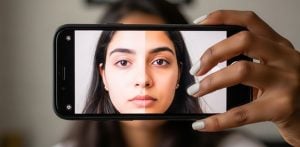"They let users customise a romantic partner"
AI and Machine Learning (ML) have made exponential strides in recent years, transforming various aspects of our world.
However, one alarming trend has emerged – AI porn.
Whilst the programming behind virtual assistants and robotic models has benefitted certain industries, people are manipulating this technology to create AI girlfriends, deepfakes, and porn.
Some may see this as a natural evolution of human-computer interaction, but the potential risks associated with porn addiction and abuse raise concerns.
We dive into the intricacies of AI porn, the issue of deepfake videos, how virtual girlfriends could hinder relationships and why sexual-related abuse could increase.
Disclaimer: If you are currently experiencing symptoms of porn addiction or problematic sexual behaviour, you are not alone. Seek support from a professional.
What Is AI Porn?

AI porn, often involving deepfakes, superimposes images onto existing ones, crafting a virtually indistinguishable reality.
The customisable realism of AI porn allows users to tailor explicit content to specific fantasies, creating a cycle of desire and consumption.
In scientific terms, as outlined by Unplug Nation, AI porn stimulates the brain’s reward system, trapping individuals in an addictive cycle.
Real-life narratives reveal severe implications, including damaged relationships, eroding mental health, and faltering self-esteem.
The societal consequences include social isolation, strained relationships, and reduced productivity.
As noted above, the main example of AI porn is deepfakes.
The resulting images and videos are so lifelike that distinguishing them from authentic content becomes a daunting challenge.
We’ve seen instances of this on social media involving politicians, musicians, and world figures.
But, communities are also seeing multiple celebrities used in videos that are erotic or of a sexual nature. This issue is especially prominent in India.
Here, women such as Kajol, Katrina Kaif, and Alia Bhatt have all fallen victim to some promiscuous deepfake video.
Although they’ve constantly urged authorities and commissions to monitor social media platforms, the expansion of AI is almost too difficult to contain.
While the technology behind AI porn is undeniably impressive, the ramifications of its application are disturbing and consequential.
Shockingly, statistics from Sensity.ai reveal that a staggering 90% to 95% of this technology finds its application in the realm of non-consensual pornography.
AI Porn & Abuse

It’s been long argued that consistent porn consumption and addiction can lead to sexual-related abuse or justification.
In-depth research by Bravehearts supports this, who found:
“An electric shock study provided evidence that violent pornographic material made males more aggressive toward females.”
Within this study, they also found:
“Afterwards, the participants were given the opportunity to give the research team member an electric shock (a fake machine, unbeknownst to the participants) if they wished.
“The participants who had viewed violent rape footage and had met with an insulting female team member administered the largest shock.”
Therefore, traditional porn can be associated with abuse.
AI porn may also extend to the realm of simulated abuse, featuring videos depicting acts such as rape, incest, and other forms of exploitation.
Compounding the issue is the fact that creators are not constrained by the limitations of the human body or the potential for severe physical harm, given that real individuals are not involved.
This opens the door to the production of sexual content that surpasses the boundaries imposed by reality.
The implications of this explicit content are particularly concerning for young children and teenagers, who are increasingly exposed to porn at earlier ages.
The powerful influence of porn is already well-documented.
In this context, AI-generated porn not only pushes the boundaries of ethical content creation but also amplifies the potential harm it can inflict on societal attitudes and behaviours.
Virtual Companionships and AI Girlfriends

One of the most intriguing revelations within the AI space is AI girlfriends.
Powered by advanced machine-learning algorithms, these are virtual entities designed to simulate human-like interactions, emotions, and behaviours.
While some see these companionships as a form of escape, the inherent risks lie in their transactional nature.
AI girlfriends are commercialised to be ‘real’, however, it is only a one-way connection where these ‘robots’ are used for self-pleasing acts.
Men turning to AI companionship may seek an escape from reality, leading to potential delusions as they blur the lines between the digital and real worlds.
This can exacerbate sex addiction, as the hyper-realistic and always-accessible nature of AI girlfriends may deepen addictive behaviours.
Long-term reliance on AI for emotional and social needs can worsen loneliness and isolation, hindering genuine human interactions crucial for psychological health.
Additionally, the agreeable nature of AI girlfriends may stunt emotional development by preventing users from experiencing crucial moments of personal growth.
In certain Asian regions, particularly Japan and China, there is a discernible interest in virtual companionship.
To emphasise this popularity, Fan Feifei and Ma Si wrote in their 2022 China Daily article:
“The artificial intelligence-powered digital humans, who are similar to real humans in appearance and behaviour, are capable of providing 24-hour online companionship, humanlike conversation and emotional support.
“They will likely become an essential part of people’s daily lives, industry experts said.
“Lin Kaikai and Ye Youyou, two companion-oriented virtual beings, were recently launched by Chinese tech giant Baidu Inc.
“[They are] powered by Baidu’s Plato, an AI model for dialogue generation that is trained on over 10 billion parameters collected from social media conversations in both English and Chinese.
“The two digital humans have a smooth, more humanlike interaction.”
These findings can be transferable to those in South Asia too, especially India. In January 2024, The Indian Express revealed:
“Mere days after launch, OpenAI’s new GPT store is already facing moderation challenges.
“The store offers customised versions of ChatGPT, but some users are creating bots that go against OpenAI’s guidelines.
“According to a report by Quartz, a search for ‘girlfriend’ brings up at least eight AI chatbots marketed as virtual girlfriends.
“With suggestive names like ‘Your AI girlfriend, Tsu’, they let users customise a romantic partner.
“This breaks OpenAI’s ban on bots ‘dedicated to fostering romantic companionship’.”
This shows how AI girlfriends could become the new trend in the future which will heavily impact the traditional views of marriage among South Asians.
It also opens up the opportunity for creators to use AI to generate virtual girlfriends that comply with sexually abusive traits as they’re not directly interacting with real women.
AI & Porn Addiction

Given the rise of AI porn, deepfakes, and virtual girlfriends, means the rate of porn addiction could also rise.
The figures for porn addiction are already alarming.
For example, the UK Addiction Treatment Group (UKAT) found that 60,000 Britons sought online help for porn addiction in 2022.
This was double the figure of 30,000 in 2021.
Additionally, FHE Health reported that 28,258 people view porn every second in the US alone.
Even in South Asia, India is one of the highest consumers of porn.
This consumption can be from innocent enjoyment, however, watching explicit content can also be a coping mechanism for people.
Some may turn to categories such as “hardcore”, “BDSM”, “extreme”, etc, as they cater to their desires.
And, high addiction rates can cause more people, especially men, to need more fulfilling entertainment that goes against certain pornographic guidelines and safety measures.
Therefore, AI opens up a world where individuals can create their own content that fills their addiction further.
Breaking free from this requires commitment and strategic implementation of self-help techniques.
Regular physical exercise, cultivating new hobbies, and adopting a Nofap lifestyle are suggested approaches.
However, with an ever-increasing AI world, will this become more difficult?
AI, with its profound impact on various aspects of our lives, has ventured into the intricate realms of virtual companionship and porn generation.
The risks associated with AI girlfriends and AI-generated porn highlight the need for ethical considerations, legal regulations, and comprehensive approaches to address the potential harms.
As society grapples with these challenges, individuals must be empowered with awareness and resources to navigate the uncharted territories shaped by the intersection of AI and human intimacy.






























































